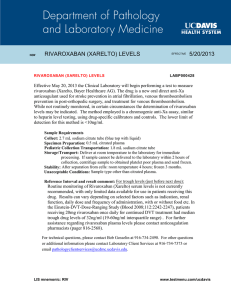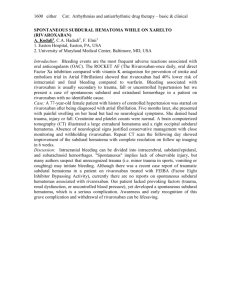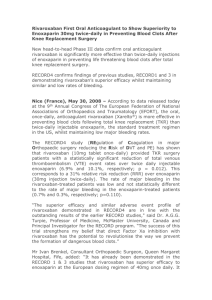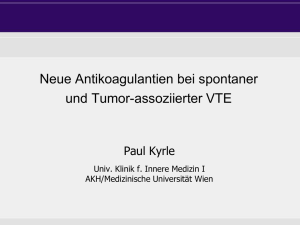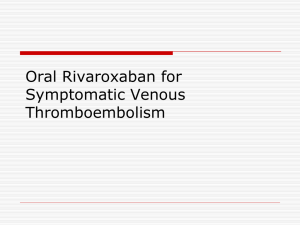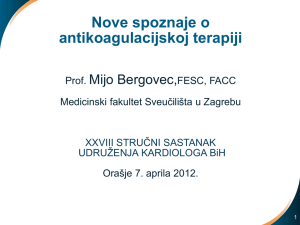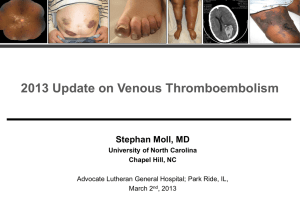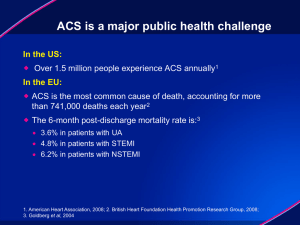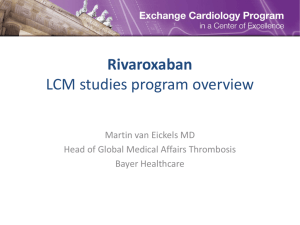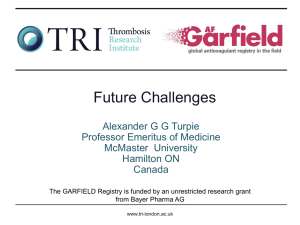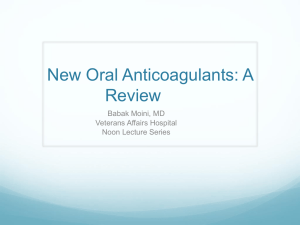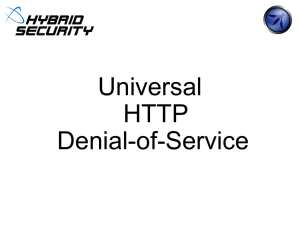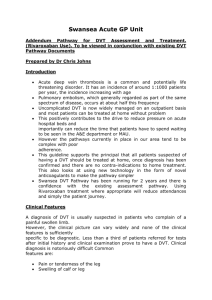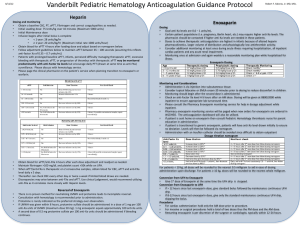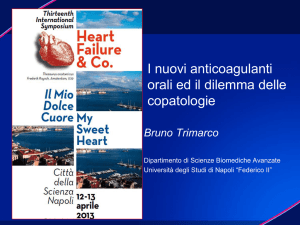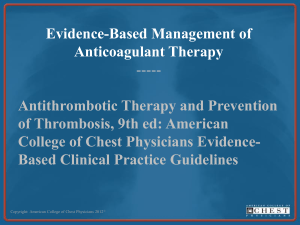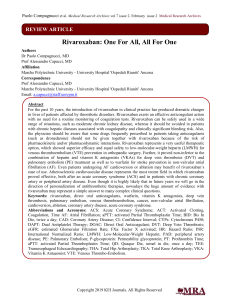EINSTEIN-PE
advertisement
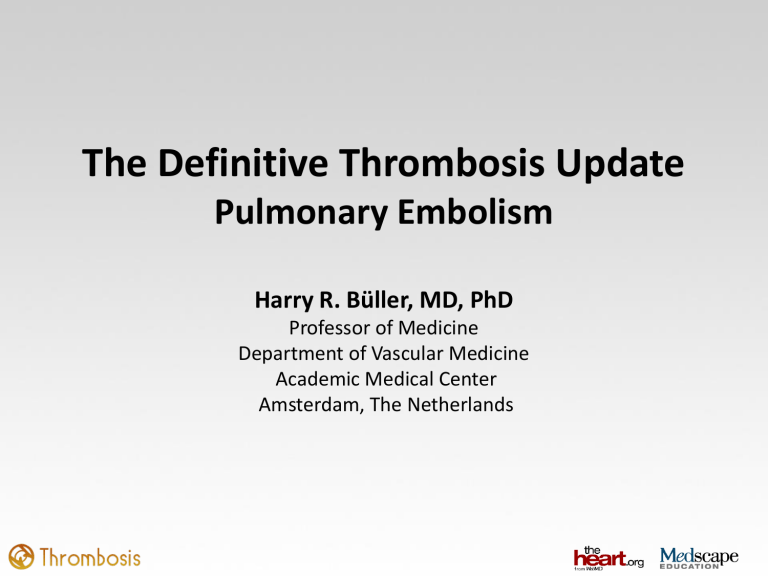
The Definitive Thrombosis Update Pulmonary Embolism Harry R. Büller, MD, PhD Professor of Medicine Department of Vascular Medicine Academic Medical Center Amsterdam, The Netherlands Rivaroxaban • • • • • Specific, direct factor Xa inhibitor High, oral bioavailability Rapid onset of action Half-life: 7 to 11 hours Dual mode of elimination – One-third of drug is excreted unchanged by the kidneys – Two-thirds of drug is metabolized by the liver: half excreted renally, half excreted via the hepatobiliary route • Phase 2 dose-finding studies indicated that for VTE treatment, a regimen consisting of rivaroxaban 15 mg, twice daily for 3 weeks followed by rivaroxaban 20 mg, once daily for the subsequent period appeared most optimal EINSTEIN-PE Randomized, Open-Label, Event-Driven, Noninferiority Study Up to 48 hours of Confirmed PE without DVT N = 4833 Rivaroxaban 15 mg, 2x/d for 3 weeks then 20 mg, 1x/d heparin/fondaparinux treatment permitted before study entry Enoxaparin, 2x/d ≥ 5 days + VKA to target INR = 2.5 (range 2-3) Primary outcome: symptomatic recurrent VTE Secondary outcomes: clinically relevant bleeding (major bleeding + clinically relevant nonmajor bleeding); all deaths + other vascular events • 30 days posttreatment period, predefined treatment period of 3, 6, or 12 months • Noninferiority margin: 2.0 • 88 primary efficacy outcomes needed Patient Groups Total patients = 4833 Rivaroxaban Enoxaparin/VKA (n = 2420) (n = 2413) ITT population 2419 2413 Safety population (as treated) 2412 2405 Per-protocol population 2224 2238 Withdrawal of consent 66 118 Lost to follow-up 8 10 EINSTEIN–PE Investigators, et al. N Engl J Med. 2012;366:1287-1297. Patient Characteristics ITT Population Males, % Age, mean (years) Body mass index, mean (kg/m2) Creatinine clearance, % < 30 mL/min 30-49 mL/min 50-79 mL/min ≥ 80 mL/min Active cancer, % Intended treatment duration, % 3 months 6 months 12 months Anatomical extent baseline PE, % Limited (single lobe ≤ 25% of vasculature) Intermediate Extensive (multiple lobes > 25% of entire vasculature) Rivaroxaban (n = 2419) 54.1 57.9 28.3 Enoxaparin/VKA (n = 2413) 51.7 57.5 28.4 0.2 8.6 26.3 64.3 4.7 <0.1 7.9 24.6 67.0 4.5 5.3 57.3 37.4 5.1 57.5 37.5 12.8 57.5 12.4 59.0 24.7 23.9 EINSTEIN–PE Investigators, et al. N Engl J Med. 2012;366:1287-1297. EINSTEIN-PE: Primary Efficacy Outcome Analysis Rivaroxaban Enoxaparin/VKA First symptomatic recurrent VTE Recurrent DVT Recurrent DVT + PE Nonfatal PE Fatal PE/unexplained death where PE cannot be ruled out (n = 2419) n % 50 2.1 18 0.7 0 22 0.9 (n = 2413) n % 44 1.8 17 0.7 2 < 0.1 19 0.8 10 6 0.4 0.2 HR 1.12 0.75 0 1.68* 1.00 Rivaroxaban superior Rivaroxaban noninferior 2.00 Rivaroxaban inferior P = .57 for superiority P = .0026 for noninferiority (2 sided) (1 sided) *Potential relative risk increase < 68.4%; absolute risk difference 0.24% (-0.5 to 1.02). Büller HR. ACC 2012. EINSTEIN-PE: Primary Efficacy Outcome: Time to First Event ITT Population Cumulative Event Rate, % 3.0 Rivaroxaban n = 2419 2.5 2.0 Enoxaparin/VKA n = 2413 1.5 1.0 HR: 1.12; P < .0026 (noninferiority) 0.5 0.0 TTR: 62.7% 0 30 60 90 120 150 180 210 240 270 300 330 360 Time to Event, days No. of Patients at Risk Rivaroxaban 2419 2350 2321 2303 2180 2167 2063 837 794 785 757 725 672 Enoxaparin/VKA 2413 2316 2295 2274 2155 2146 2050 835 787 772 746 722 675 From EINSTEIN–PE Investigators, et al. N Engl J Med. 2012;366: 1287-1297. EINSTEIN-PE: Principal Safety Outcome: Major or Nonmajor Clinically Relevant Bleeding Cumulative Event Rate, % Safety Population 15 14 13 12 11 10 9 8 7 6 5 4 3 2 1 0 Enoxaparin/VKA n = 2405 Rivaroxaban n = 2412 Rivaroxaban Enoxaparin/VKA 10.3% 0 30 60 90 120 150 0.90 (0.76-1.07) 11.4% 180 210 240 HR (95% CI) P = .23 270 300 330 360 Time to Event, days No. of Patients at Risk Rivaroxaban 2412 2183 2133 2024 1953 1913 1211 696 671 632 600 588 313 Enoxaparin/VKA 2405 2184 1923 1887 1092 687 660 620 589 574 251 2115 1990 From EINSTEIN–PE Investigators, et al. N Engl J Med. 2012;366: 1287-1297. EINSTEIN-PE: Major Bleeding Safety Population Cumulative Event Rate, % 3.0 Rivaroxaban Enoxaparin/VKA 1.1% 2.2% HR (95% CI) 0.49 (0.31-0.79) P =.0032 2.5 Enoxaparin/VKA n = 2405 2.0 1.5 1.0 Rivaroxaban n = 2412 0.5 0.0 0 30 60 90 120 150 180 210 240 270 300 330 360 Time to Event, days No. of Patients at Risk Rivaroxaban 2412 2281 2248 2156 2091 2063 1317 761 735 700 669 659 350 Enoxaparin/VKA 2405 2270 2224 2116 2063 2036 1176 746 719 680 658 642 278 From EINSTEIN–PE Investigators, et al. N Engl J Med. 2012;366: 1287-1297. EINSTEIN-PE: Key Secondary Outcomes Enoxaparin/ Rivaroxaban VKA Outcome % % HR (95% CI) Net clinical benefit* 3.4 4.0 0.85 (0.63-1.14) Total mortality 2.4 2.1 1.13 (0.77-1.65) On-treatment • Cerebrovascular events 0.5 0.5 • ACS 0.6 0.9 < 0.1 < 0.1 0.1 < 0.1 0.2 0.2 Off-treatment (+ 30 days) • Cerebrovascular events • ACS ALT > 3 × ULN + bilirubin > 2 × ULN *Primary efficacy outcome plus major bleeding. EINSTEIN–PE Investigators, et al. N Engl J Med. 2012;366:1287-1297. EINSTEIN-PE: Conclusions In patients with acute symptomatic PE with or without DVT, rivaroxaban showed • Noninferiority to LMWH/VKA for efficacy: HR = 1.12 (95% CI, 0.75-1.69); P = .0026 for noninferiority margin of 2.0 • Similar findings for principal safety outcome: HR = 0.90 (95% CI, 0.76-1.07); P = .23 • Superiority for major bleeding: HR = 0.49 (95% CI, 0.31-0.79); P = .0032 • Consistent efficacy and safety results irrespective of age, body weight, gender, kidney function, or cancer • No evidence for liver toxicity The Definitive Thrombosis Update Venous Thromboembolism Professor the Lord Ajay K. Kakkar, MD, PhD Prevention of Atrial Fibrillation-Related Stroke Keith A. A. Fox, MB, ChB Secondary Prevention Following Acute Coronary Syndrome Freek W. A. Verheugt, MD Pulmonary Embolism Harry R. Büller, MD, PhD
